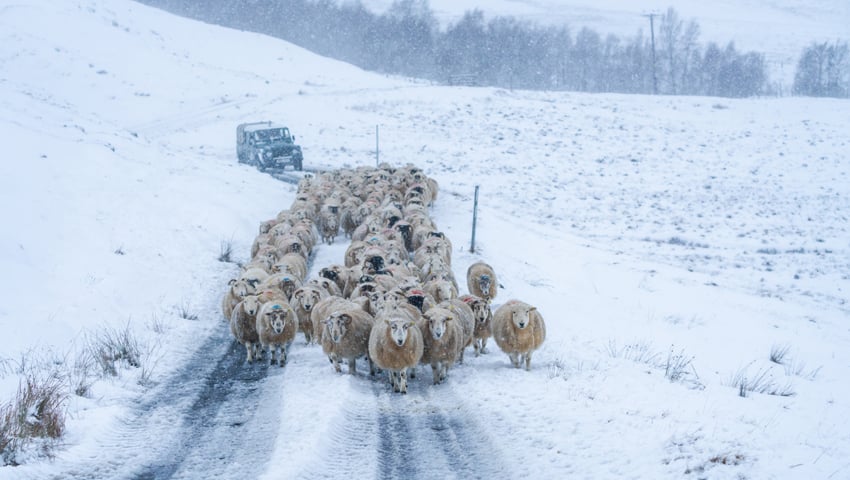New analysis reveals that hill farmers’ livelihoods are at risk from delays to new government support schemes. Hill farmers are only receiving 8 per cent or £39m of the government’s new farming support scheme, the Sustainable Farming Incentive, despite the uplands occupying around 15 per cent of England’s area.
The overhaul and expansion of the Countryside Stewardship ‘higher tier’ scheme, vital for upland and other marginal farming areas, was repeatedly delayed under previous governments, having been beset by problems since its initial launch in 2015. It is now not due to be available until next summer.
Incomes from farming in the uplands are typically amongst the lowest of all farm sectors, with recent data for 2023/24 giving an average farm business income for hill farms of £23,500. Delays to the higher tier scheme therefore present a particular risk to the incomes of hill farmers, and those in similarly economically marginal landscapes. Evidence suggests a big increase in spending and uptake of the higher tier scheme is needed to meet climate and nature targets.
Commenting on the analysis, Tom Lancaster, land, food and farming analyst at the Energy and Climate Intelligence Unit (ECIU) said, “Hill farmers are often not rich and are less likely to be affected by changes to inheritance tax, but delays to new government schemes could have an outsized negative impact on their livelihoods.
“The Countryside Stewardship higher-tier scheme, designed to support farmers to create and restore habitats like woodlands, which would help to reduce flood risk downstream, has been repeatedly delayed under previous governments. Any further delays will put hill farmers finances in jeopardy.
“British people are concerned by the state of British nature and many hill farmers are keen to get on with the job of restoring it, locking up carbon emissions as they do. Government targets are unachievable without them. For the Treasury, these schemes provide the best value for money, and a quick start is essential to avoid the looming prospect of an underspend against this government’s commitment to farmers.”
Neil Heseltine, an upland farmer and member of the Nature Friendly Farming Network (NFFN) from Malham in North Yorkshire, said, “We’ve been waiting for years for Defra to provide us with the support we need to do more for nature and climate change on our farm. We are ready, willing and able, but the support to do so just hasn’t been there yet. I don’t begrudge our lowland peers the funding they’re getting, I just want some of it to flow up the hill to allow us to do the same.
“If it doesn’t, climate and nature will suffer. And as the old subsidies are phased out, I don’t know what hill farmers will do if we can’t get into these more ambitious, higher-paying, higher-tier schemes we’ve long been promised. We’re at a critical point in the green farming transition, and this new Defra team need to put their money where their mouth is before it’s too late and ensure the schemes we were promised are available as soon as possible.”
The delays to the higher-tier schemes are compounded by fears that when it does launch, not enough farmers will be able to get into it. Alongside issues with the Landscape Recovery scheme, this risks hindering efforts to reduce flood risk for downstream communities and farmland, if farmers in the uplands aren’t able to get the support they need to slow the flow of water and hold more of it in hills.
The higher-tier predecessor scheme, Higher Level Stewardship (HLS), which closed for new applications in 2014, illustrates how important these more ambitious schemes are for hill farmers.
In 2024, the uplands received 42 per cent or £50m of the remaining payments under the HLS scheme. This amounted to an average across all farm holdings in upland National Character Areas (NCAs) of £4508, including those holdings not in the scheme. By comparison, the same upland areas received £3608 per holding in the SFI. This compared to a national average of £4825 per holding in the SFI, and £1693 in HLS.
There are no upland landscapes in the list of the 30 National Character Areas receiving the most funding from the SFI, with lowland arable and dairy farming landscapes dominating. By contrast, 12 of the 22 upland NCAs are in the top 30 receiving the most from HLS, with 7 in the top 10. These include the Cumbria High Fells, North Pennines and Yorkshire Dales.
Experience with previous schemes suggests that around 45-50 per cent of the overall farming budget will need to be allocated to the higher tier and Landscape Recovery schemes to meet climate and nature targets and spend the budget effectively. At the present, only 24 per cent of the land management scheme budget goes to these, and 12 per cent of the total farming budget. This poses a risk that Defra will face a big underspend against their budget commitment to spend £1.8 billion on green farming schemes by next year unless they can move much faster to increase uptake of these more ambitious schemes.
Read the analysis, Distribution of funding across different land management schemes in England
